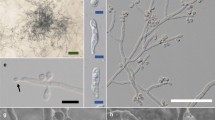Abstract
The in vitro production of pycnidia bySeptoria tritici was examined on six media reported to induce the formation of fruiting bodies. Among 26 freshly isolated cultures from various parts of the world, consistent differences in growth type were found which were only partially influenced by nutritional and environmental conditions. Cultures with yeast-like growth produced hardly any pycnidia or pseudopycnidia, while cultures with intermediate or mycelial growth types produced them frequently. Incubation in continuous darkness induced intermediate to mycelial growth types rather than yeast-like growth types in some cultures, and concomitantly the production of more pycnidia. Potato-dextrose agar induced intermediate to mycelial growth types and production of (pseudo)pycnidia more often than V8 agar and wheat leaf extract agar, which had previously been reported to be especially beneficial to (pseudo) pycnidium formation byS. tritici. Isolates with a consistently yeast-like growth type, producing (virtually) no fructifications under any of the experimental conditions, were slightly stimulated to form pseudopycnidia on water agar supplemented with sterile pieces of maize, wheat or carnation leaves.
Similar content being viewed by others
References
Annone, J.G., 1984. Cultural types ofSeptoria tritici Rob. ex Desm.: occurrence in Washington, stability and virulence. M.Sc. Thesis, Washington State University, Pullman, Washington, 67 pp.
Benedict, W.G., 1971. Differential effect of light intensity on the infection of wheat bySeptoria tritici Desm. under controlled environmental conditions. Physiological Plant Pathology 1: 55–66.
Cooke, B.M. & Jones, D.G., 1970. The effect of near-ultraviolet irradiation and agar medium on the sporulation ofSeptoria nodorum andS. tritici. Transactions of the British Mycological Society 54: 221–226.
Djerbi, M., Kerlan, C. & Bompeix, G., 1974. Observations sur la morphogenèse et la cytologie des fructifications duSeptoria tritici Rob. et Desm. Annales de l'Institut National de la Recherche Agronomique de Tunisie 47 (3), 56 pp.
Eyal, Z., Scharen, A.L., Prescott, J.M. & Ginkel, M. van, 1987. The Septoria diseases of Concepts and methods of disease management. Mexico, D.F.: CIMMYT.
Fisher, N.L., Burgess, L.W., Toussoun, T.A. & Nelson, P.E., 1982. Carnation leaves as a substrate and for preserving cultures ofFusarium species. Phytopathology 72: 151–153.
Hilu, H.M. & Bever, W.M., 1957. Inoculation, oversummering and suscept-pathogen relationships ofSeptoria tritici onTriticum species. Phytopathology 47: 474–480.
King, J.E., Cook, R.J. & Melville, S.C., 1983. A review ofSeptoria diseases of wheat and barley. Annals of Applied Biology 103: 345–373.
Lee, N.P. & Jones, D.G., 1974. Rapid method for spore production in threeSeptoria species. Transactions of the British Mycological Society 62: 208–211.
Pierobom, C.R., 1983. Studies on pycnidial and ascocarpic fungi which cause leaf spots in wheat in Washington. Ph.D. Thesis, Washington State University, Pullman, Washington.
Scott, P.R., Sanderson, F.R. & Benedikz, P.W., 1988. Occurrence ofMycosphaerella graminicola, teleomorph ofSeptoria tritici, on wheat debris in the UK. Plant Pathology 37: 285–290.
Shearer, B.L., Zeyen, R.J. & Ooka, J.J., 1974. Storage and behaviour in soil ofSeptoria species isolated from cereals. Phytopathology 64: 163–167.
Shipton, W.A., Boyd, W.J.R., Rosielle, A.A. & Shearer, B.L., 1971. The commonSeptoria diseases of wheat. Botanical Review 27: 231–262.
Sokal, R.R. & Rohlf, F.J., 1969. Biometry. Freeman and Co. San Fransisco. 776 pp.
Weber, G.F., 1922.Septoria diseases of wheat. Phytopathology 12: 537–585.
Zelikovitch, N. & Eyal, Z., 1989. Maintenance of virulence ofSeptoria tritici cultures. Mycological Research 92: 361–364.
Author information
Authors and Affiliations
Rights and permissions
About this article
Cite this article
Kema, G.H.J., Annone, J.G. In vitro production of pycnidia by Septoria tritici. Netherlands Journal of Plant Pathology 97, 65–72 (1991). https://doi.org/10.1007/BF01974270
Accepted:
Issue Date:
DOI: https://doi.org/10.1007/BF01974270




